A month before the start of COP25, Chilean President Sebastián Piñera announced to the world that his country would no longer host the UN climate conference.
Pressured by huge protests which called for more social and climate justice, the Chilean government passed the position of COP25 host to Spain, but continued repressing the demonstrations with brutality. Even so, Chilean organisations and individuals managed to find creative and courageous ways to demand that governments act to solve the climate crisis, respect the right of expression and guarantee opportunities for all.
Here are 11 moments related to COP25 in which the Chileans showed that when life gives us lemons, we can make a splendid pisco sour with it.
1.When Indigenous peoples resisted and became even stronger
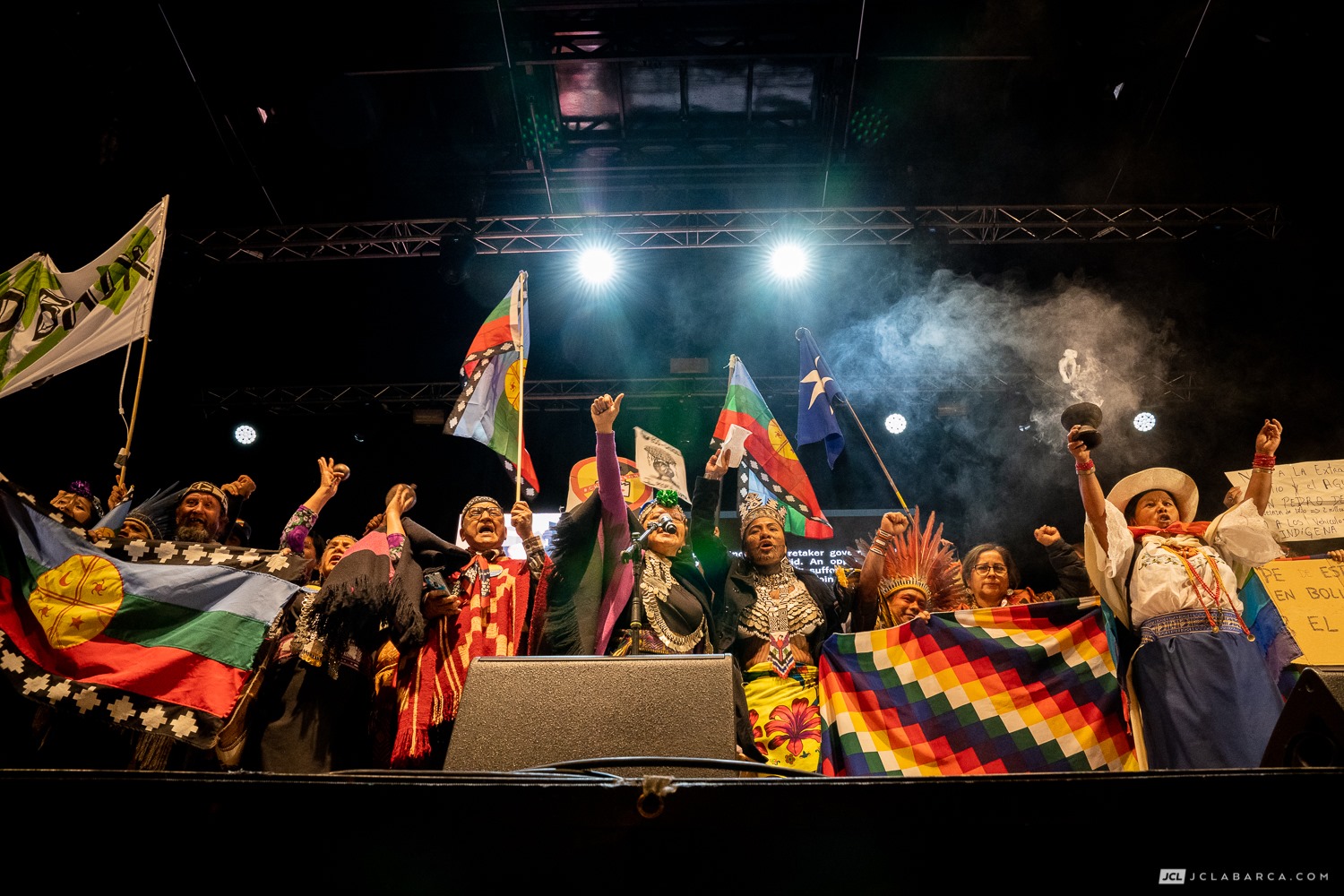
Photo: Minga Indigena COP 25
Even with sudden changes and constant repression, the Indigenous peoples of Chile and Latin America resisted and shone at COP 25 in Madrid. The Indigenous Minga , (Indigenous Peoples Summit), scheduled to happen in Chile, quickly adapted to a new scenario in Madrid and lead several important debates about climate change and how it affects native peoples. They were present in all areas at COP 25 and their voices were heard by people from all over the world, a unique moment for Peoples used to repression by European settler-colonialists.
2. Launch of the documentary: Indigenous Voices from Latin America – We Are the Document of the Earth
Throughout 2019, 350.org Latin America documented the opinions of different peoples and ethnic groups about climate change, the use of land, water, fossil fuels, and territory. Their visions became this beautiful 30 minute documentary. Essential viewing for anyone who wants to understand the vision of Indigenous peoples in Latin America. The consultations were conducted with the objective of preparing the Indigenous Climate Charter, which was finalized and delivered at COP 25 in Madrid.
3.Delivery of the Indigenous Climate Letter
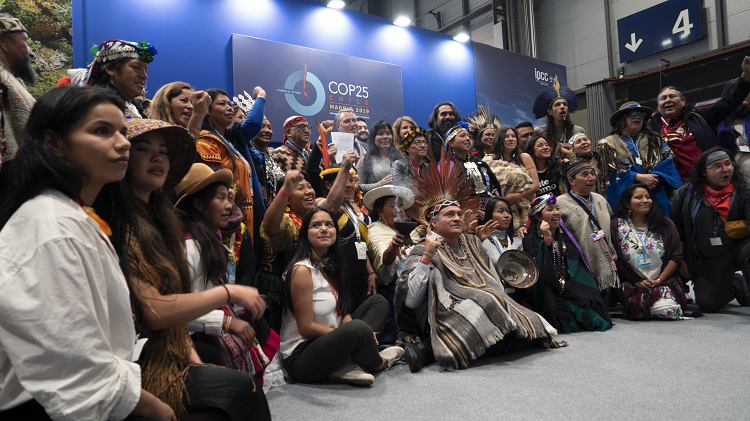
Photo: Hugo Duchesne/350.org
With a transparent and clear message, the Indigenous peoples of the Americas, the Caribbean, and the West Indies collectively prepared the final draft of the Indigenous Climate Letter of the region, which was finalized during COP25. The document is both a warning and a strong claim of Indigenous rights and nature. It was presented on Tuesday (10/12) to the leaders of the almost 200 countries that participated in the meeting in Madrid, Spain. It was given to Andrés Landerretche, coordinator of the presidency of the COP25, and Gonzalo Muñoz. A ceremony full of symbolism and energy flooded the auditorium of the meeting with color, rituals and diversity. The document will also be disseminated by Indigenous peoples in their countries. See the full text here: Indigenous Climate Letter to COP 25
4. When thousands of people marched for the climate in Santiago and Madrid simultaneously.
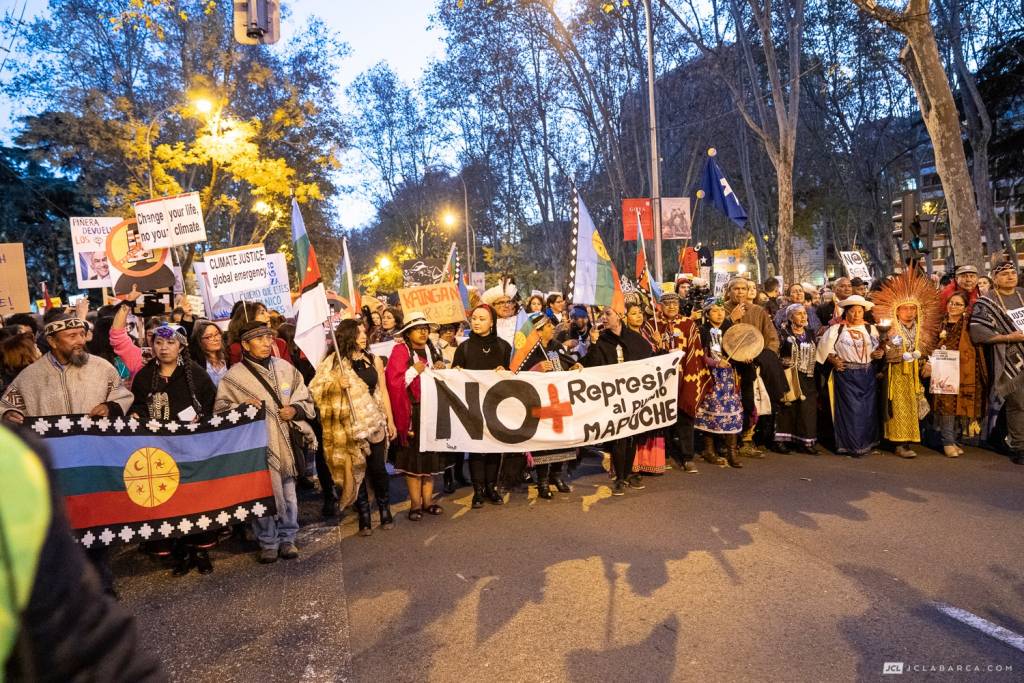
On December 6, hundreds of thousands of people marched for climate in the streets of Madrid, where the climate conference was taking place, and in Santiago, where it would have taken place. Together, the demonstrators from the two capitals gave a message of unity and strength of the climate movement and showed the representatives of governments gathered that week that they can no longer postpone the solutions to the climate emergency. The native peoples of Chile and Latin America led the March in Madrid and were applauded by more than 500,000 people.
5. When the Peoples’ Summit chose to remain in Chile and showed that another world is possible.
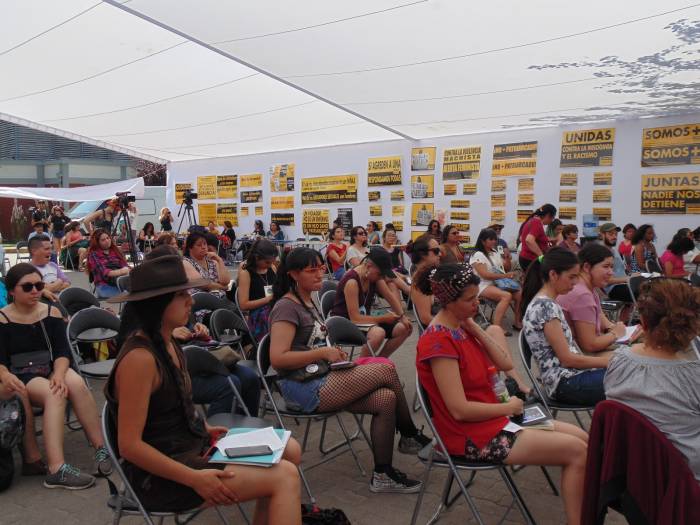
Cumbre de los Pueblos (People’s Summit) is one of the main global events parallel to the UN climate conference. This year, the organizers decided to maintain the meeting in Santiago, even after the COP25 was transferred to Madrid. Representatives of more than 160 grassroots social and environmental organizations, with a strong presence of Chilean civil society and Latin American Indigenous movements, met to exchange experiences and discuss ways to achieve their demands for climate justice. The final declaration of the meeting (in Spanish) summarised the main conclusions of the participants.
6. When the CHAOCARBÓN Alliance joined 350.org Latin America to protest against the neo-colonialism of European companies.
In front of the REPSOL headquarters in Madrid, protesters were against #CO2Colonialism. “In Latin America, we are facing a neo-colonization by oil companies. Portuguese companies are investing in Mozambique, Angola, and Brazil, as well as Spanish companies such as Repsol, are investing in drilling the oceans, thermoelectric and other fossil fuels, ”said Nicole Oliveira, director of 350.org in Latin America.
The CHAOCARBÓN Alliance fights for the end of coal projects in Chile, with the aim of achieving in the short term the urgent closure of coal and thermoelectric plants, which constitute one of the most important sources of pollution in these 5 main zones: Tocopilla, Mussels, Huasco, Quintero Puchuncaví, and Colonel.
7. When Chilean activists from Fridays for Future showed the world’s governments that youth movements are not messing around.
https://www.instagram.com/p/B58WyR2leD_/?igshid=v8oea5xla5qd
A striking feature of COP25 was the massive, intelligent and insistent presence of young climate activists putting pressure on governments to commit to real climate solutions. Chileans were an important part of this movement, helping to bring Latin America’s perspective to the global debate. Members of Fridays for Future, such as the young Mapuche people (an Indigenous people from Chile) and activist Joel Panichine (second from left), did not let state representatives forget that climate solutions have to be put into practice now. In the photo shared by Leonardo di Caprio, Joel is joined by fellow youth activists and Greta Thunberg.
8. When a Chilean activist from Fridays for Future explained why young people around world are mobilising.
Wait for it 👁️
Chile and the world is waking up. Watch this powerful opening statement from @FFFSantiago activist Angela Valenzuela at #COP25.#ChileDesperto #ClimateActionNow #TiempoDeActuar pic.twitter.com/SCPnwXTOf9
— 350 dot org (@350) December 3, 2019
Meet Angela Valenzuela, a member of Fridays for Future in Santiago and 350.org staff. She was one of the activists who led the demands of the youth to the many civil society events at COP25. She sums up why the youth climate movement is growing so rapidly. Spoiler: Governments don’t seem very committed to solving the most serious problems of humanity.
9. When art challenged police violence and pollution.

Artist: Francisca Fuentes
Against brutality and contamination, art. This would define the work of two Chilean groups that are using artistic expressions to demand social and climate justice in their country. One of them, OjoChile, produces posters and animations focused on the theme of the eyes, a reference to the more than 350 demonstrators who had eye problems as a result of police action during the protests in the last two months. ChaoCarbón, a campaign for the end of the coal-fired power plants, created this beautiful website with information on the theme and this exhibition with incredible engravings by 28 artists about the plants in the country. Both groups actively participated in the protests and debates held during COP25.
10. When Chileans helped bring the International Court of the Rights of Nature to Santiago.
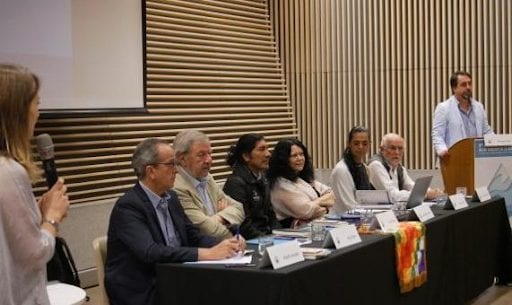
Intellectuals and activists held the 5th trial of the International Tribunal for the Rights of Nature, in the Chilean capital. The three cases judged this time had to do with Chile’s environmental problems and resulted in recommendations for the state to take steps to resolve these issues.
11. When the women of Las Tesis spread to the world their protest against gender violence.
It’s hard to talk about Chileans rocking in the last few weeks and not start with the feminist collective Las Tesis. The group created a performance to protest against police violence directed at protesters (at least 194 cases of sexual violence by police officers were reported in two months) and sexism in Chilean society. The “sticky” (in the words of the group itself) music they sing and the strength of their message went viral, with the performance being repeated by women around the world.
12. Bônus: When Chilean poetry inspired us to fight.

Although Chilean Gabriela Mistral, the first Latin American woman to win a Nobel Prize for Literature in 1945, did not live to accompany COP25, her poems become more current every day. At a time when societies urgently need to transform into action, Gabriela Mistral’s words that dealt so wonderfully with issues such as the value of nature and social justice sounded more necessary than ever at COP25. May her poetry continue to inspire change.